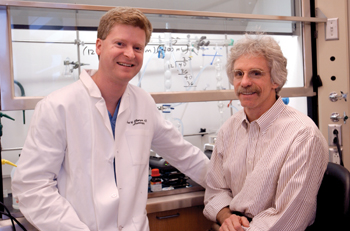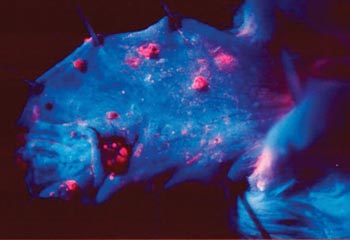
Chemist Darryl Bornhop, Ph.D., (right) and neurosurgeon Dr. Reid Thompson have received a grant from the National Science Foundation. Dana Johnson
Glowing tag lights up tumor cells

Epithelial cancer cells glow in this hamster cheek pouch after topical application of a special fluorescent molecule that "tags" cancer cells so they can be seen during surgery.
The National Science Foundation has thrown its support behind an innovative interdisciplinary collaboration at Vanderbilt to develop a fluorescent “tag” that can light up stray brain cancer cells so they can be better seen and removed during surgery.
Chemist Darryl Bornhop, Ph.D., and neurosurgeon Dr. Reid Thompson hope their project will lead to improved cure rates for brain cancer patients because the ability to cure is directly related to how thoroughly tumor cells can be removed during surgery.
The NSF grant will provide $600,000 over three years.
“Despite aggressive treatment, the median survival for patients with malignant glioma is less than a year,” said Thompson, associate professor of Neurological Surgery and director of the Vanderbilt Brain Tumor Center. “Our current imaging techniques do not allow us to see all of the tumor cells infiltrating the normal brain tissue. The fewer tumor cells we leave behind, the better the cure for these patients, but we have to be able to see them. With this tag, these cells light up like a light bulb. It’s really amazing.”
The researchers have developed a brain tumor specific imaging method by hooking a molecule called a lanthanide chelate, which fluoresces in a wave-length that can be seen with the naked eye, to a molecule that selectively attaches to a receptor expressed on the surface of brain cancer cells. They also have added a gadolinium molecule so that the cells can also be seen with magnetic resonance imaging.
The lanthanide chelate has an extending arm, or hook, to which other molecules can be attached. For the brain tumor project, it has been attached to a molecule called PK11195, which binds to the peripheral benzodiazepine (BPR) receptor. These binding sites are densely displayed on the surface of malignant glioma cells. However, the lanthanide chelate could be attached to other ligands that bind to other types of cancer cells, so the implication for this work extends beyond brain tumors.
The work is being done in animal models, with plans for clinical trials under way.
Bornhop noted that with brain surgery in particular, being able to precisely distinguish between tumor and normal cells is critical.
“What really impressed me about brain cancer is how infiltrating the disease can be, and how precise the surgery to remove those infiltrating cells needs to be,” said Bornhop, professor of Chemistry. “It’s one thing to remove a bit more colon than you need to just to be safe; it’s quite another to remove a bit more brain than necessary.”
An additional advantage to the fluorescent tag is that it might help distinguish between tumor cells and normal cells that are dying as a result of radiation therapy, Thompson said. With current imaging techniques, both look the same, but a patient with necrotic tissue does not necessarily have to undergo additional surgery.
Thompson and Bornhop began their collaboration a couple of years ago, while Bornhop was at Texas Tech and Thompson was at Cedar-Sinai Medical Center. They continued their work together after Thompson joined the VICC last year, but then the opportunity arose this summer to bring Bornhop here as part of the department of Chemistry and the Vanderbilt Institute for Chemical Biology.
The proximity will enable them to move the work forward much more quickly, they said.
“I have new lab space that I can see from here,” Bornhop said, pointing out the window in Thompson’s Medical Center North office.
“The only way to make these things happen is to transcend departmental boundaries to develop new ways to treat disease. This collaboration is really starting to show promise.”













